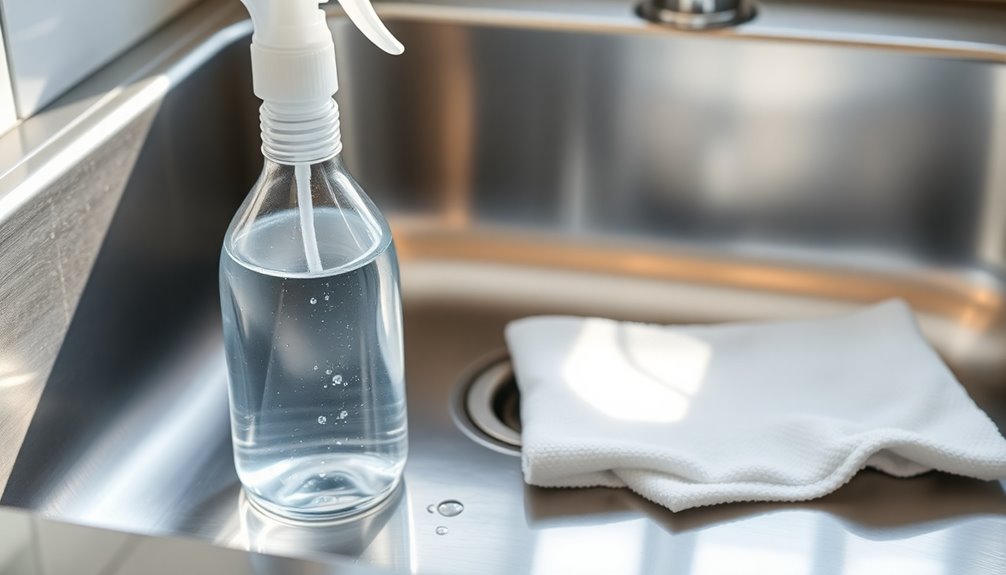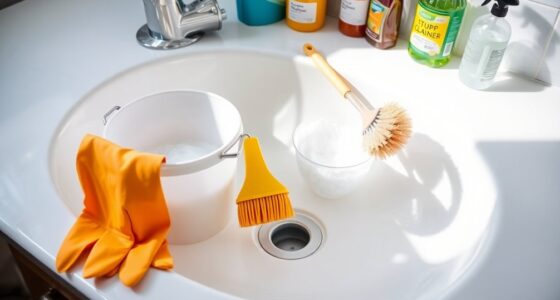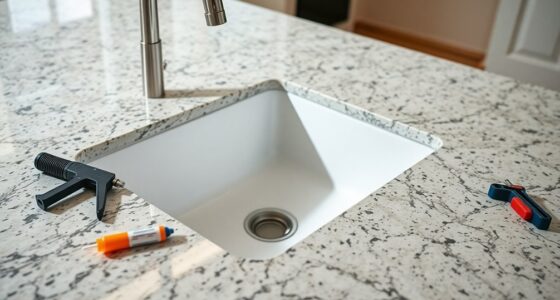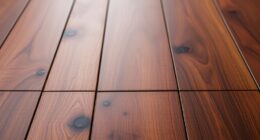To remove hard water stains from your stainless steel sink, you can use white vinegar, lemon, baking soda, or club soda. Spray a mixture of equal parts vinegar and water on the stains, let it soak, then scrub with a microfiber cloth. Alternatively, rub a halved lemon on the stains or create a paste with baking soda and water. Pour club soda directly on stains for an easy lift. For more effective tips, keep exploring additional methods!
Key Takeaways
- Mix equal parts of white vinegar and water in a spray bottle, spray on stains, and let it soak for 5-10 minutes before scrubbing.
- Rub a halved lemon on stained areas, allowing the juice to sit for 5-10 minutes, then rinse thoroughly.
- Create a baking soda paste by mixing 1/4 cup baking soda with 1/2 cup water, apply to stains, let sit, and rinse.
- Pour club soda directly onto stains, scrub gently with a microfiber cloth, and rinse well with clean water.
- Regularly dry the sink after each use to prevent new hard water stains from forming.
Why Hard Water Stains Form on Stainless Steel
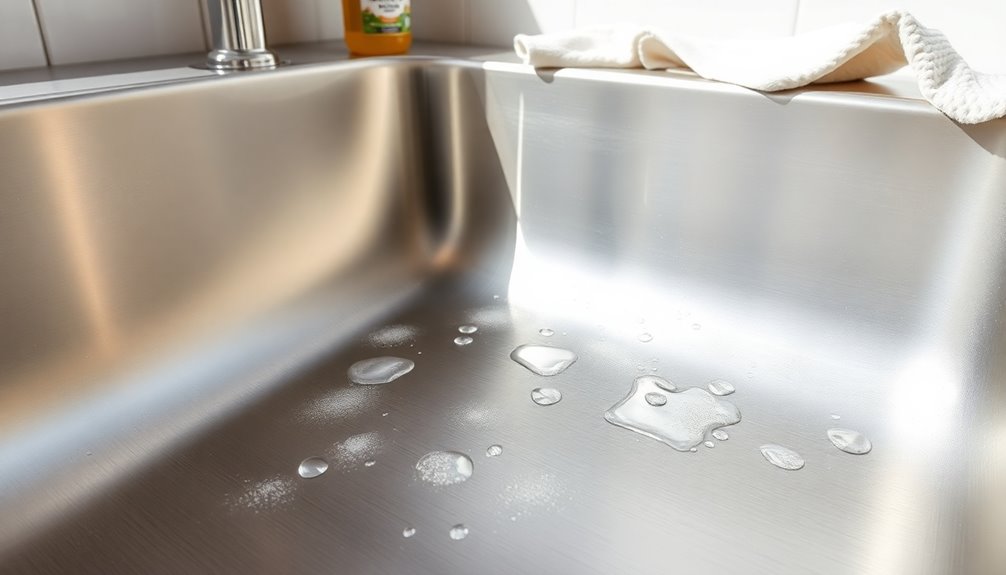
When hard water evaporates, it leaves behind stubborn mineral deposits on stainless steel surfaces, primarily due to the high concentrations of calcium and magnesium found in hard water.
These mineral deposits create hard water stains that form on stainless steel sinks, resulting in unsightly white cloudy spots and streaks.
Over time, if you don't clean these stains regularly, they can accumulate and become more pronounced, leading to potential oxidation and even rust.
While these stains don't impact the efficiency of your fixtures, they can be frustrating to deal with.
Installing a water softener can help reduce mineral content in your water, making it easier to maintain your stainless steel surfaces and minimize hard water stains.
Materials Needed
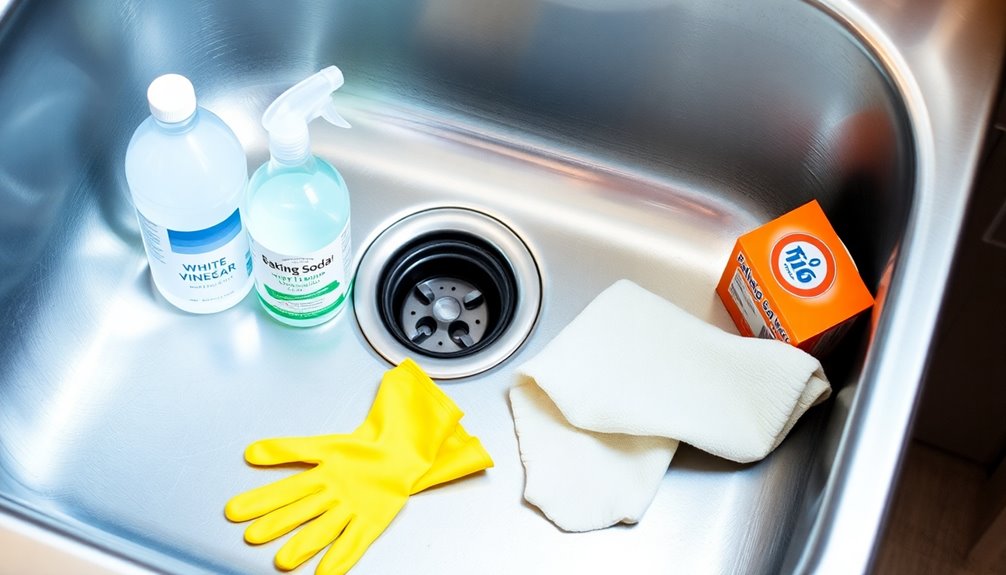
To tackle hard water stains effectively, you'll need a few essential cleaning supplies and household ingredients.
Gather items like white vinegar, baking soda, and club soda, along with recommended tools like microfiber cloths and a spray bottle.
Having these materials ready will make the cleaning process smoother and more efficient.
Essential Cleaning Supplies
Gathering the right cleaning supplies is essential for effectively tackling hard water stains. You'll need a few key items to make the process smoother and more efficient. Here's a quick reference table for your cleaning arsenal:
| Item | Purpose | Notes |
|---|---|---|
| White Vinegar | Natural cleaner to dissolve stains | Use in a spray bottle |
| Baking Soda | Create a paste for scrubbing tough stains | Mix with water in a small bowl |
| Microfiber Cloth | Wipe and polish without scratching | Guarantees a streak-free finish |
| Club Soda | Effervescent cleaner for lifting stains | Gentle on stainless steel |
With these supplies on hand, you're ready to restore your stainless steel sink to its original shine!
Household Ingredients Options
You have several effective household ingredients at your disposal for tackling hard water stains.
White vinegar, when mixed with water in equal parts, works wonders as a natural cleaner. Simply spray it onto the affected area and watch those stains lift away.
Lemon juice is another great option; rub a halved lemon over the stains, let it sit for 5-10 minutes, then wipe clean.
Baking soda serves as a gentle abrasive; create a paste with water or sprinkle it directly on the sink.
If you need an alternative, cream of tartar can replace baking soda for tough stains.
And don't forget about club soda, which can help dissolve mineral deposits effortlessly.
Recommended Tools List
Having the right tools on hand can make all the difference when tackling hard water stains.
To effectively clean your stainless steel sink, gather white vinegar and baking soda to create a potent cleaning solution. Vinegar acts as an acidic cleaner, while baking soda provides gentle abrasion to lift stubborn stains without scratching.
You might also want club soda for its carbonation, which helps break down tough spots when poured directly. A spray bottle is essential for applying your cleaning solution evenly across the stained areas.
Finally, keep microfiber cloths nearby; they're perfect for scrubbing and drying your sink while preventing scratches.
With these tools, you'll be well-equipped to restore your sink's shine.
Remove Hard Water Stains on Stainless Steel Using Vinegar
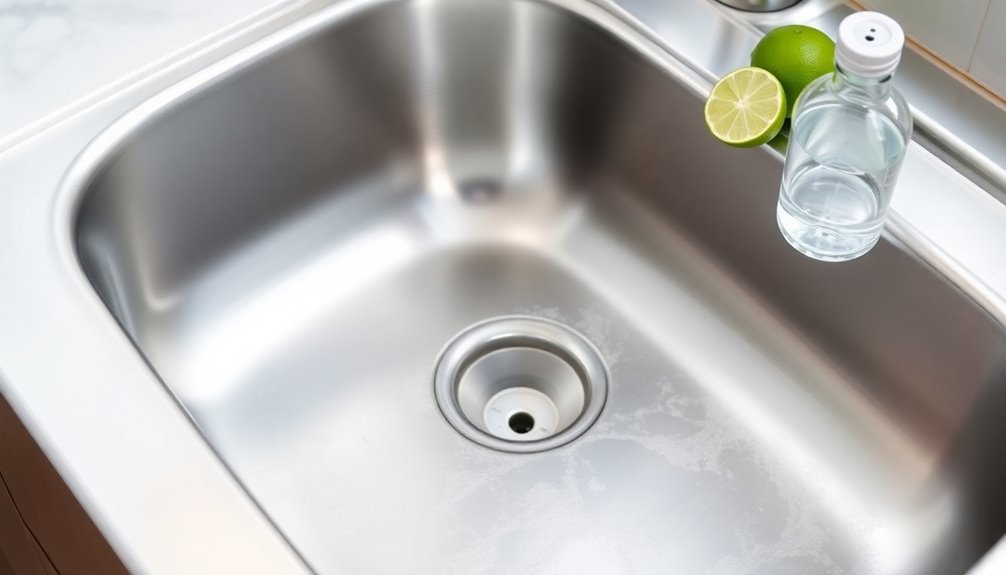
To tackle hard water stains on your stainless steel sink, start by mixing equal parts white vinegar and water in a spray bottle.
Spray the solution on the stains and let it soak for 5-10 minutes to loosen the mineral deposits.
After that, rinse the area well and dry it with a microfiber cloth to keep new stains at bay.
Vinegar Solution Preparation
Creating a vinegar solution to tackle hard water stains on stainless steel is a simple and effective process. Start by mixing equal parts of white vinegar and water in a spray bottle. Shake the spray bottle gently to combine the ingredients.
| Ingredient | Amount |
|---|---|
| White Vinegar | 1 cup |
| Water | 1 cup |
Once mixed, spray the solution directly onto the hard water stains. Allow it to sit for 5-10 minutes. After soaking, gently scrub the area with a microfiber cloth or sponge to lift the mineral deposits. Finally, rinse the sink thoroughly with clean water to eliminate any vinegar residue, and dry the surface with a microfiber cloth to prevent new stains from forming.
Application and Soaking Time
Once you've prepared your vinegar solution, it's time to apply it to the hard water stains on your stainless steel sink.
Spray the vinegar directly onto the stained areas and let it soak for about 5-10 minutes. This soaking time allows the vinegar to effectively break down the mineral deposits causing the stains.
After soaking, take a microfiber cloth or sponge and gently scrub the stained surface. Be careful not to scratch the stainless steel while you lift the stains away.
The combination of vinegar and a light scrub should clear up most marks, making your sink look fresh again. Additionally, maintaining regular maintenance of your sink can prevent hard water stains from accumulating in the future.
Once you've scrubbed, you're all set to move on to rinsing and drying!
Rinsing and Drying Steps
After you've let the vinegar solution work its magic on the hard water stains, it's crucial to rinse the area thoroughly with clean water.
This step guarantees all vinegar residue is removed, preventing potential corrosion on your stainless steel sink. Use a gentle stream of water to wash away any leftover solution.
Once rinsed, grab a clean microfiber cloth for drying. Wipe the sink completely to avoid new hard water stains from forming.
Make sure to dry along the grain of the stainless steel, which keeps its shine and prevents scratches.
To maintain a spotless sink, remember that regular rinsing and drying after each use can greatly reduce hard water stains over time.
Remove Hard Water Stains on Stainless Steel Using Lemon
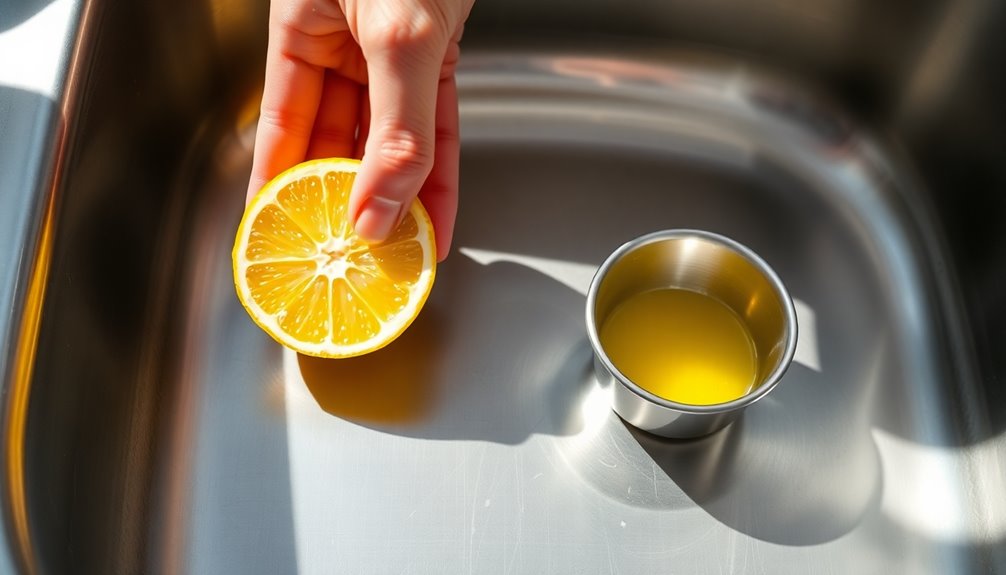
If you're looking for a natural way to tackle hard water stains on your stainless steel sink, using lemon can be incredibly effective.
Start by cutting a lemon in half and rubbing the cut side directly onto the stained areas. Allow the lemon juice to sit for 5-10 minutes to break down the mineral deposits. The acidity in the lemon juice works wonders to remove hard water stains while leaving a fresh scent.
Afterward, gently scrub the surface with a soft microfiber cloth to lift the stains without scratching the stainless steel. Rinse thoroughly with clean water to eliminate any leftover lemon juice, then dry the sink with a clean microfiber cloth to prevent new hard water spots from forming.
Remove Hard Water Stains on Stainless Steel Using Baking Soda
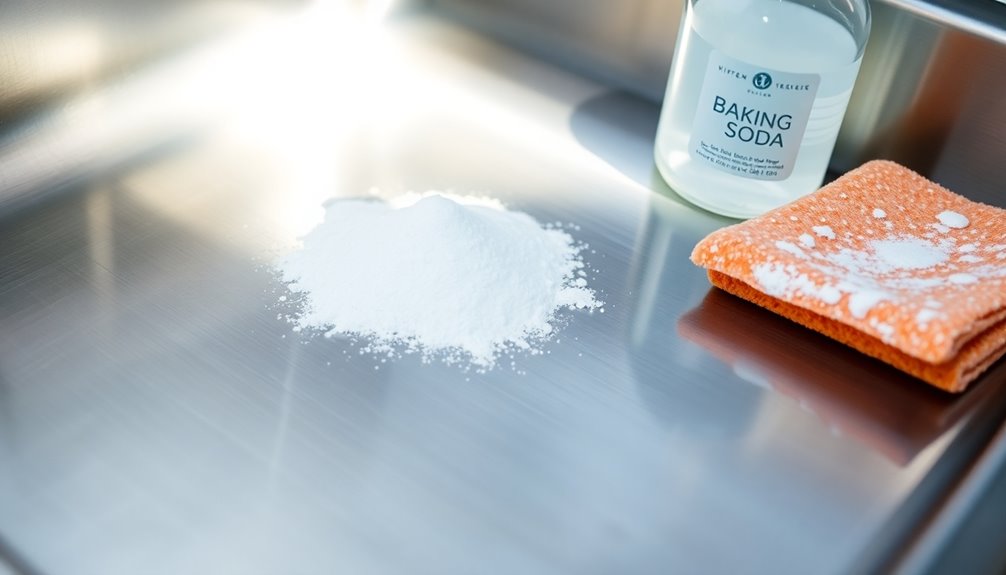
Baking soda is a powerful ally in the battle against hard water stains on your stainless steel sink.
To effectively remove hard water stains, follow these simple steps:
- Combine 1/4 cup of baking soda with 1/2 cup of water to create a paste.
- Apply the paste directly onto the stains and let it sit for a few minutes. For tougher stains, spray white vinegar over the paste to activate a foaming reaction.
- Scrub gently with a non-scratch sponge or a clean microfiber cloth, then rinse thoroughly with clean water.
Finally, to prevent new hard water stains from forming, dry your sink with a clean microfiber cloth after each use.
With these tips, your stainless steel sink will shine like new!
Remove Hard Water Stains on Stainless Steel Using Club Soda
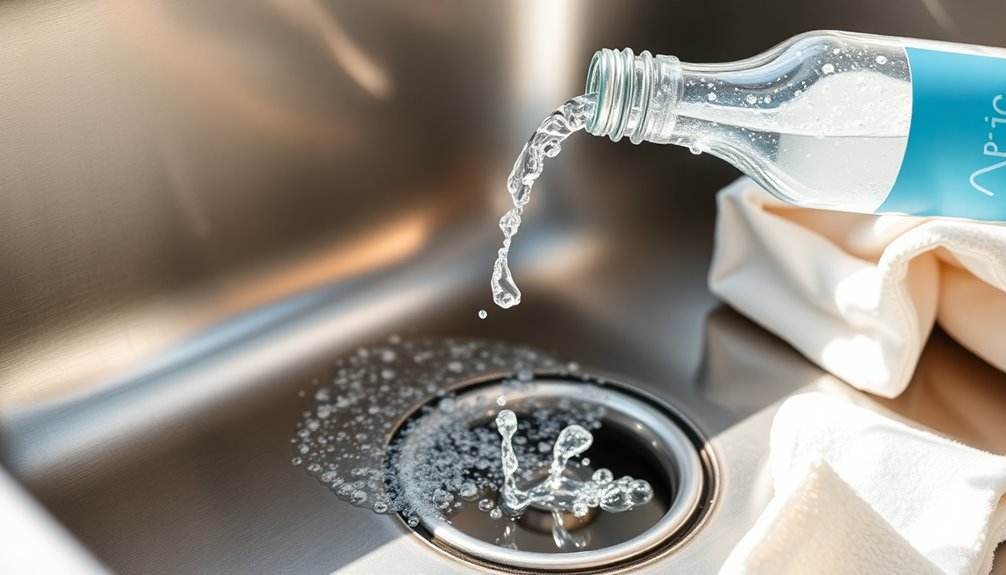
Club soda is a surprisingly effective tool for tackling hard water stains on your stainless steel sink.
To start, pour club soda directly onto the stained area. The carbonation in the club soda helps lift those pesky mineral deposits.
Next, grab a microfiber cloth and gently scrub the surface, making sure to follow the grain of the stainless steel to avoid scratches.
After you've scrubbed, rinse the area thoroughly with clean water to remove any remaining residue.
Finally, dry the sink immediately with a clean microfiber cloth to prevent new hard water stains from forming.
For best results, incorporate club soda into your regular cleaning routine to keep your stainless steel sink shining bright and stain-free!
How to Prevent Hard Water Stains on Stainless Steel
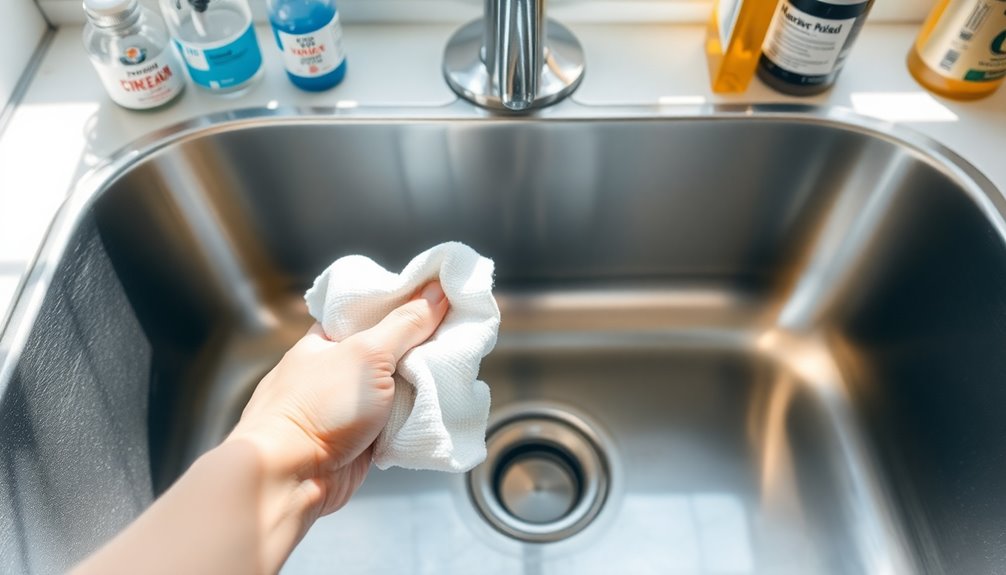
To keep hard water stains at bay on your stainless steel sink, it's essential to adopt a few proactive habits. Here are three effective ways to prevent hard water stains:
- Install a water softening system: This tackles hard water issues at the source, reducing mineral content and preventing stains.
- Dry the sink after each use: Use a soft microfiber cloth to wipe away water droplets, preventing mineral deposits from forming.
- Regularly clean with vinegar or lemon juice: These acidic agents help maintain your sink's appearance and counteract potential stains.
Additionally, consider using a stainless steel cleaner or applying a protective coating to create a barrier against mineral buildup. Regular filter replacement for air purifiers can also contribute to maintaining overall home cleanliness by reducing airborne minerals that may settle on surfaces.
Additional Tips for Maintaining Your Stainless Steel Sink
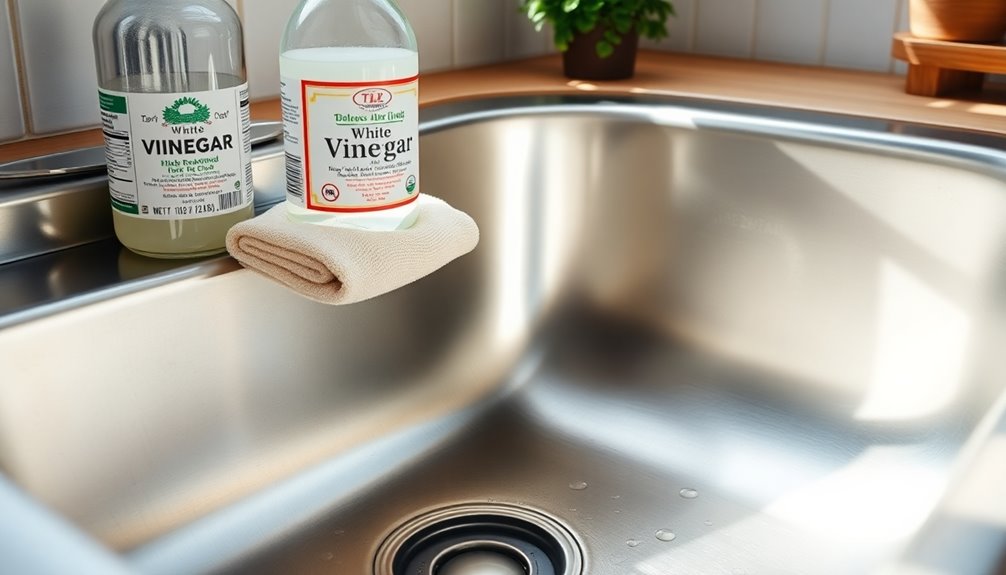
Maintaining your stainless steel sink doesn't have to be a chore; just a few simple habits can keep it looking great. Regularly drying your sink with a soft cloth after each use prevents hard water stains from forming. Consider using a stainless steel cleaner weekly to create a protective barrier against water spots. Installing a water softener can also reduce mineral content in your water, helping minimize hard water stains.
| Task | Frequency |
|---|---|
| Dry with a soft cloth | After each use |
| Use stainless steel cleaner | Weekly |
| Apply baking soda mixture | Monthly |
| Check water softener | Every 6 months |
| Avoid abrasive materials | Always |
These simple practices can greatly enhance your sink's longevity and shine!
Frequently Asked Questions
How Do You Remove Hard Water Buildup From Stainless Steel?
To remove hard water buildup from stainless steel, start by mixing equal parts white vinegar and water in a spray bottle.
Spray the solution on the affected areas and let it sit for 5-10 minutes. Then, scrub with a microfiber cloth to lift the stains.
For tougher buildups, make a paste of baking soda and water, apply it, spray with vinegar, and scrub.
Remember to dry your sink after each use to prevent future stains!
How Do You Remove Calcium Deposits From a Stainless Steel Sink?
When it comes to tackling calcium deposits, you've gotta strike while the iron's hot!
Start by mixing 1/4 cup baking soda with 1/2 cup water to form a paste. Apply that to the stained areas, then spritz it with white vinegar to get a fizz going.
Let it sit for 5-10 minutes, scrub gently with a non-abrasive sponge, and rinse thoroughly.
If needed, lemon juice works wonders too!
How Do You Remove Calcified Hard Water Stains?
To remove calcified hard water stains, you can start by mixing equal parts white vinegar and water in a spray bottle.
Spray the solution on the stains and let it sit for 5-10 minutes. Then, gently scrub with a microfiber cloth.
For tougher stains, create a paste using baking soda and water, apply it, and spray with vinegar.
Finally, rinse the area with clean water to prevent future stains. Regular maintenance helps too!
How Do You Remove Stubborn Limescale From a Stainless Steel Sink?
So, you've decided to host a limescale convention in your stainless steel sink? Brilliant choice!
To evict those stubborn guests, mix 1/4 cup of baking soda with 1/2 cup of water, creating a paste. Slather it on the limescale and let it chill for about 10-15 minutes.
For a dramatic exit, spritz it with white vinegar and watch the fizz. Don't forget to rinse it all away afterward—cleanliness is key!
Conclusion
Now that you know how to tackle those pesky hard water stains, your stainless steel sink can shine like a knight's armor. Regular maintenance and preventive measures will keep it looking great for years to come. Remember, just as a well-tended garden flourishes, a little care goes a long way in preserving your sink's beauty. So roll up your sleeves and take pride in your sparkling kitchen—it's a reflection of your hard work and attention to detail!
